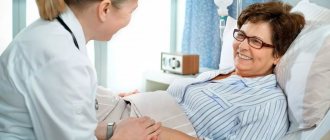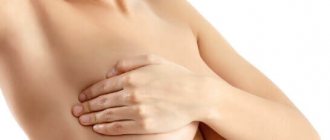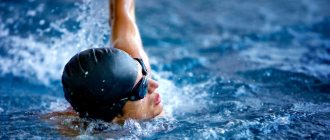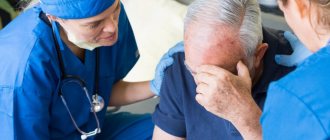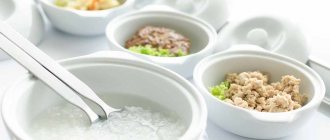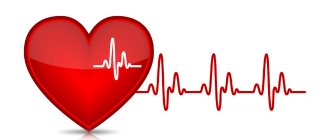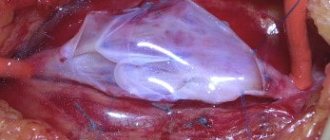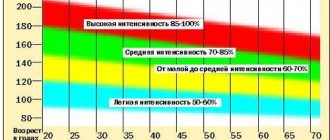Many of us have heard the name “ministroke,” but not everyone knows what it is and why this condition is dangerous.
To begin with, we note that, at the same time, it is necessary to distinguish between this condition and a stroke, and not.
Why?
- A disease that doesn't exist? Experts do not separately identify such a disease as microstroke. In the medical lexicon, this is called transient cerebrovascular accident (TCI);
- "Micro" disease? The prefix “micro” in the word is only misleading: it does not mean at all that there is no need to be afraid of this condition or that there is no need to take urgent measures to eliminate it; rather, on the contrary, it emphasizes the “kinship” with stroke with only one difference - in symptoms. The symptoms of a minor stroke are not as severe as those of a cerebral hemorrhage, and they go away much faster.
- Is it possible to recover? After a mini-stroke, the body can often recover without the help of a doctor, but it is still worth getting examined: even if the symptoms have already disappeared, the specialist should know that they were there. Thus, it is more likely that relapses and strokes will be prevented.
Causes of microstroke
Oddly enough, even young people (30-35 years old) are at risk for a mini-stroke. Experts attribute this to the environment, stress, and the presence of certain diseases.
The most common causes of microstroke are:
- Atherosclerosis is the formation of plaques on the inner surface of blood vessels. These same plaques can interfere with normal blood circulation;
- Congenital and acquired problems with blood vessels (varicose veins; thrombophlebitis; cerebrovascular crises);
- Diabetes mellitus, which thins the vascular wall;
- High blood pressure (BP);
- Previous heart attacks, arrhythmias and other heart diseases;
- Taking medications that increase the risk of thrombosis (for example, contraceptives);
- Vegetative-vascular dystonia (provokes circulatory disorders and pressure surges);
- Excess weight (the endocrine gland, which is adipose tissue, can produce an increased amount of estrogens, leading to the formation of blood clots);
- Excessive physical activity;
- Hereditary diseases that reduce the diameter of arteries, etc.
Increasingly, cases of illness transferred “on the legs” are being recorded. Since a mini-stroke does not have significant symptoms, often people busy with work or other activities do not pay due attention to the symptoms, do not consult a doctor in time, and simply continue to go about their business. This course of things can only aggravate the situation: in order to pass without complications, the disease must be diagnosed in time, and treatment must begin as soon as possible.
Expert opinion
Author: Tatyana Aleksandrovna Kosova
Head of the Department of Rehabilitation Medicine, neurologist, reflexologist
According to statistics, the number of cases of first-time transient cerebrovascular accident is increasing every year. A microstroke is provoked by various factors. It has been noted that the disease is most common among men of working age. According to clinical studies, in 10-15% of cases, myocardial infarction develops after a transient cerebrovascular accident. 30-40% of patients experience a major stroke over the next 5 years. Therefore, it is important to seek medical help on time and undergo preventive examinations.
Diagnosis of microstroke at the Yusupov Hospital is carried out using modern medical equipment. European CT and MRI installations make it possible to accurately determine the location of the lesion and its extent. An individual treatment and rehabilitation program is developed for each patient. The recovery period takes place under the supervision of experienced neurologists, massage therapists, exercise therapy instructors and physiotherapists. A personal approach can reduce the time of hospital stay and reduce the risk of recurrent microstroke.
Recovery after a stroke
What to take care of in advance
“The family needs to prepare before their loved one is discharged from the hospital,” says the expert. – First, set up a place for your ward. Look where it is better to put the bed and bedside table so that both you and him will be comfortable. If a person’s left hand does not move, the bedside table should be on the right so that the person can reach the objects on it.
Visit the primary care physician at the hospital and find out what medications should be on hand when the patient is discharged. If a person is discharged on a Friday, for example, they need to continue taking their medications on both Saturday and Sunday. Waiting for a local doctor until Monday is wrong.
Constant use of medications is one of the basic rules of rehabilitation and recovery. The list will be indicated in the epicrisis. You need to be prepared for the fact that there may be a lot of medications.
“Therefore, at first it is better for relatives to control the process of taking medications. I recommend purchasing a pill box in which you can put your medications for a week. It’s better for someone in the family to be responsible for this,” advises Tatyana Lysova.
It is worth purchasing in advance, if necessary diapers , wet wipes, skin creams - they will be needed for hygiene procedures.
If a person has suffered a major stroke and is inactive, it makes sense to purchase an anti-bedsore system .
It is necessary to have a blood pressure monitor . The pressure will have to be controlled.
Symptoms of a microstroke
As already noted, a micro-stroke often hardly manifests itself: the symptoms are very mild, which is why they are so easy to overlook. But it’s still worth paying attention to these first signs of the disease:
- Numbness of the whole body (or one part of it, so it may be impossible to smile or raise both arms);
- Dizziness;
- Severe headache;
- Double vision;
- Unsteady movements, weakness, desire to sit down or lie down.
To diagnose a microstroke at home, you can use the FAST test. It was developed in America for emergency doctors so that they could easily diagnose cerebral hemorrhage. This test is also suitable for a micro-stroke, since the symptoms (facial distortion, weakened arms and incoherent speech) are also present in this case, although they pass much faster. FAST is an abbreviation, but the word itself is translated from English as “quickly” - one of the main rules when diagnosing a disease.
F (face - “face”) - you need to pay attention to the victim’s face: it can be unnaturally skewed.
A (arms - “hands”) - the patient’s hands do not obey: they are weakened, trembling and do not rise up.
S (speech - “speech”) - words are confused, it is impossible to pronounce even a simple sentence without errors.
T (time - “time”) - time: so precious in the case of this disease. It is better to start diagnostics as soon as the first signs appear, because as soon as they pass (with a microstroke this usually takes no more than an hour or two), the patient will feel great again. But for emergency doctors, diagnosing the symptoms will help a lot.
How to avoid thrombosis after a stroke
— To prevent swelling of the lower extremities and thrombosis, the feet should be warm, the socks on the ward should be without elastic bands . Or you can cut the elastic with scissors from the front, says Tatyana Lysova. - If a person is sitting, the legs should be in an elevated position. It happens that relatives sit the ward in front of the TV in the morning, and he sits like that until the evening, and his legs swell and turn into “decks”.
lymphatic drainage massage of the legs will help relieve swelling : soft stroking movements from top to bottom to the toes and back up, warming and kneading the swelling with the warmth of your hands. In this case, you can use baby oil, it does not clog pores and moisturizes the skin well.
Rehabilitation after a mini-stroke
How to recover after a mini-stroke?
The following principles that patients adhere to contribute to rehabilitation and speedy recovery:
- A doctor is a specialist. And you need to trust specialists. If the patient is incompetent in matters of treatment and rehabilitation, it is worth following the doctor’s recommendations and taking the medications he prescribed;
- Don’t put it off until tomorrow... If a patient needs to do exercise therapy every day, this means that classes cannot be missed, otherwise the desired effect will not be achieved;
- The importance of support. After a ministroke or, worse, a stroke, the support of loved ones is very important for the patient. Sometimes they simply give up, patients become depressed, and only family and friends are able to influence and help a person they know well. You can accompany the patient to a massage or exercise therapy, help him prepare food so that it fits the diet, and just talk. Feelings of loneliness should not be present in rehabilitation.
- Systematicity. This means that if a patient is prescribed exercise therapy, he should not miss a single day; if he has a diet, then he needs to strictly follow it. In terms of timing, rehabilitation after a mini-stroke is an individual process, since everything depends on the degree of impairment and the patient’s condition.
- Gradualism. This means that the body does not recover immediately, it needs time. This means that it is better to leave the usual active workouts for later, and immediately after a micro-stroke go for a massage or exercise therapy.
Also, recovery and rehabilitation after a mini-stroke imply the following actions:
- Drug treatment
- Restoration of motor functions
- Vision restoration
- Restoration of speech function
- Normalization of psychological state
Drug treatment
Recovery of the body after a micro-stroke can occur on its own (this depends on the general health of the patient), but you still need to see a doctor: he will prescribe simple drug treatment, with the support of which the body will recover more quickly. But if the patient delays diagnosis and treatment, complications may arise. In this case, with a microstroke, the doctor prescribes the following groups of drugs responsible for restoring the body:
- improving blood microcirculation;
- improving metabolic processes in blood vessels;
- dilating vessels;
- preventing the formation of blood clots;
- stimulating brain activity;
- vitamins (to strengthen the immune system and improve brain activity).
Restoration of motor functions
A ministroke usually affects the lower and upper extremities, and motor function is impaired. The grasping reflex may disappear, weakness in the arms and legs may appear (symptoms may intensify and then it will be impossible to move at all).
The following methods are used to restore motor functions:
- Exercise therapy. Therapeutic exercise is designed to normalize muscle tone and restore strength to the muscles.
- Massage. This procedure relaxes, stimulates blood circulation and normalizes muscle tone. In this case, a massage session can be carried out both by a specialist and by the patient himself, if he is ready to strictly follow the doctor’s recommendations. You can also combine a procedure with a specialist and a home massage. This approach will speed up the recovery process.
- Physiotherapy. After a micro-stroke, the patient is usually prescribed warming, which allows the body to regain lost sensitivity.
Vision restoration
Frequent symptoms of a microstroke are double vision, darkening, spots, and even temporary blindness in one or two eyes at once. While the patient is undergoing treatment, the issue of vision restoration is dealt with by an ophthalmologist, and less often by a surgeon (if it is impossible to avoid surgical intervention). During the rehabilitation period, the patient is usually prescribed pills that normalize vision function, and is also recommended to perform special exercises that stimulate the work of the oculomotor nerve. To record progress or regression, it is recommended to visit a doctor regularly.
Restoration of speech function
Confusion of speech is another symptom of a mini-stroke, which can be cured with proper treatment. But, if after treatment the speech function is not completely restored, special classes are conducted with the patient aimed at its restoration. They are usually carried out by a speech therapist or neuropsychologist. In case of complications and serious speech disorders, all basic speech skills are studied with the patient from scratch: listening (understanding what is heard), reading, writing, speaking.
The process of speech restoration will accelerate if the patient’s relatives continue to study with him at home. For the process to be effective, in addition to training with the victim, you just need to talk (ask him simple questions, patiently waiting for an answer; tell the news; share opinions, etc.), even if this seems useless at first glance. But we must remember that a person can only speak in a linguistic environment (that is, he must constantly hear speech in order to begin to produce it), which is the task of family and friends to create during the rehabilitation period.
Normalization of psychological state
Patients who have suffered a mini-stroke often experience depression (people with a fine mental organization and women are especially prone to it due to their physiology and psyche). Relatives need to try to understand this condition: the patient suddenly lost some abilities, is forced to take pills and regularly visit the doctor. His life has completely changed. To help him overcome this condition it is necessary:
- Interact and communicate with him more often;
- Go for walks, which will provide him with physical activity;
- Help you find a new hobby or return to an old one, if possible.
As soon as rehabilitation is over, it is better for a person to return to work: to the old one or, if this is not possible, to find a new one as soon as possible.
Any activity requires a certain amount of effort and time, therefore, by getting busy, the patient will think less about problems and, accordingly, will quickly overcome a depressive state.
Where and how to undergo rehabilitation and how long will it take to recover after a mini-stroke? These are the most frequently asked questions by patients. Of course, everyone wants to return to normal life as soon as possible, go to work or go on a trip.
Rehabilitation is possible both at home and in a hospital setting. In the first case, success will depend on those who surround the patient: on their willingness to communicate, care and support. Secondly, it depends on the literacy of specialists and the development of the rehabilitation program.
The Yusupov Hospital, for example, has its own rehabilitation center, where the patient will be under the supervision of competent specialists who will go through all the rehabilitation activities with him from start to finish. Rehabilitation after a mini-stroke in the clinic is carried out according to an individual program, depending on the severity of the disorders in each individual patient.
But how long does it take to recover from a mini-stroke? Unfortunately, these are individual indicators. They depend on the general condition of the patient, whether there are complications or not, and on the approach to rehabilitation. With the correct approach of the patient to treatment and rehabilitation, usually all functions are restored within six months.
What to do if a person has a stroke?
- First of all, call an ambulance. Sometimes the minutes count.
- Provide fresh air, open windows and doors, and free the person’s neck from constricting clothing.
- Leave the person where the attack occurred. The patient cannot be moved.
- Elevate the person's head and upper body 30 degrees by placing several pillows under the thoracic spine.
- If vomiting occurs, turn the person's head to the side and ensure that the vomit passes away so that the person does not suffocate.
- In the event of an epileptic attack, carefully hold the person, turn his head to the side and insert an object wrapped in cloth into his mouth - a stick, a comb, a spoon.
- In case of cardiac arrest, immediately begin compressions through the chest and perform artificial respiration.
- Wait for the ambulance.
Forecast of microstroke
A microstroke is not the most terrible disease, it is only the first warning sign before a stroke (according to statistics, it occurs in 60% of cases after a microstroke), an opportunity for a person to change something in his life and pay special attention to health. If you follow the doctor’s advice and undergo rehabilitation in full, the consequences of a micro-stroke will be invisible (slight muscle weakness, fatigue, dizziness with a sudden change in body position, etc.) or will disappear altogether. If the patient does not pay due attention to his body, the likelihood of a relapse or even a stroke arises several times, which is already much more dangerous in its consequences, including:
- Men at a young age experience memory impairment, erectile dysfunction, frequent headaches, seizures, mood swings, and paresis. Women have similar functions to men, with one difference: the more frequent occurrence of depressive conditions. This is due to the characteristics of female physiology and psyche.
- Elderly people experience difficulty in motor activity, decreased vision, decreased memory and mental activity, speech impairment, sclerosis, and paresis.
To avoid negative consequences, it is better to diagnose any disease and begin treatment as soon as possible, and a microstroke, despite its prefix “micro,” is no exception.
Dangerous age and consequences of stroke
After age 55, the risk of stroke increases significantly. For men, the most dangerous age is considered to be from 45 to 55 years, since during this period they have a stroke 2 times more often than women.
If a person can be saved, the stroke still does not go away without leaving a trace. The person may be left partially paralyzed and lose control of urination and bowel movements. Cognitive functions decrease—problems with memory, speech, and information perception appear.
Recovery after a stroke is possible, but it often requires a lot of time and effort from both the patient and his loved ones. Therefore, it is better to prevent a stroke than to deal with its consequences later.
Prevention
Prevention is a rewarding endeavor, because any disease is easier to prevent than to treat. And the preventive measures for most diseases are the same, so if you follow simple rules, you can avoid many diseases.
What should be done?
- Maintain normal blood pressure. A microstroke occurs most often due to a sharp rise in pressure. Buy a tonometer: now these devices are small and convenient (so you can even take it with you on a trip) and measure your pressure at least once a day;
- To refuse from bad habits. And these are not just words: alcohol and coffee, for example, also provoke pressure surges, and smoking thins blood vessels;
- Dieting. A diet for the prevention of micro-stroke involves avoiding fatty, fried foods: it is important to prevent the formation of cholesterol plaques;
- Regular exercise. It is not at all necessary to run a marathon, but walking in the park every day for 40-60 minutes is advisable;
- Healthy sleep, avoiding stressful situations. Lack of normal sleep and stress can also lead to a jump in blood pressure;
- Prevention and timely treatment of vascular diseases and diabetes. These diseases provoke strokes and heart attacks, so it is better to get rid of them as soon as possible.
A microstroke is not the most terrible disease, but it can still become one without proper help. If a minor stroke develops into a traditional one, the consequences can be dire: disability or even death is not uncommon. Therefore, any disease, even a minor one in your opinion, is best treated without delay.
Recovery period
What is a microstroke, how to treat it - this is the paraphry of specialists. But the patient himself must understand that he will have to go through a fairly long recovery period. It is understood that the following recommendations from doctors will need to be followed:
- stick to a diet - give up alcohol and smoking, limit fatty and spicy foods;
- undergo medical examination every 2-3 years;
- normalize and strictly adhere to the daily routine;
- lead an active lifestyle and engage in basic physical education;
- regularly monitor blood pressure.
In addition, it is necessary to promptly treat coronary artery disease, hypertension, and arrhythmia. Only in this case can you be sure that a major stroke will be prevented.
Self-medication for microstroke is unacceptable! When the first signs of a sharp narrowing of the small vessels of the brain appear, it is necessary to seek qualified medical help.
Related services: Consultation with a neurologist Intensive care unit
Is it necessary to grind food in a blender?
If there are no problems with swallowing and chewing, then this is not necessary, the expert believes.
— The blender replaces the mechanical processing of food, that is, you “chew” the food for your ward, which is not always good. When a person chews, he produces saliva and gastric juice. Grinding food is possible when the patient has no teeth or is at risk of aspiration pneumonia. Often relatives grind food because it is more convenient for them: this way the patient will eat faster. It is not right. A person should eat at a pace that is comfortable for him and food that is familiar to him.
How to avoid relapse after a stroke
Read the epicrisis carefully , it indicates when a follow-up examination by doctors, usually a therapist and a neurologist, is necessary,” says the BOKK specialist. – Doctors have thousands of patients, so it’s your concern to invite them on time or come to see them. Close cooperation with doctors will help in recovery. Think about how to help your ward get rid of smoking and alcohol - risk factors, and organize a healthy diet.
My experience says that those who want it recover faster. The power of thought, the attitude “I must get back on my feet faster” sometimes makes the impossible possible.
Subscribe to our Facebook groups and stay up to date with the latest news! Only interesting videos on our YouTube , join us!
Self-help if you suspect a microstroke - how to help yourself if no one is around?
If alarming phenomena that are similar in symptoms to a microstroke have made themselves felt, and the patient is alone at home, he should take the following measures:
- Call one of your friends or relatives and ask them to come urgently.
- Call an ambulance , describing your complaints to the dispatcher.
- Open the windows in the apartment to ensure oxygen enters the room.
- Free the chest from constricting clothing , remove the belt (if any).
- Take a lying position , placing a pillow under your shoulders and head. You can place a basin near the bed in case of vomiting.
- A bandage or handkerchief soaked in cold water and applied to the forehead can alleviate the general condition.
- Until the ambulance arrives, any movement should be minimized . You also need to try to relax and tune in to positive thoughts.
